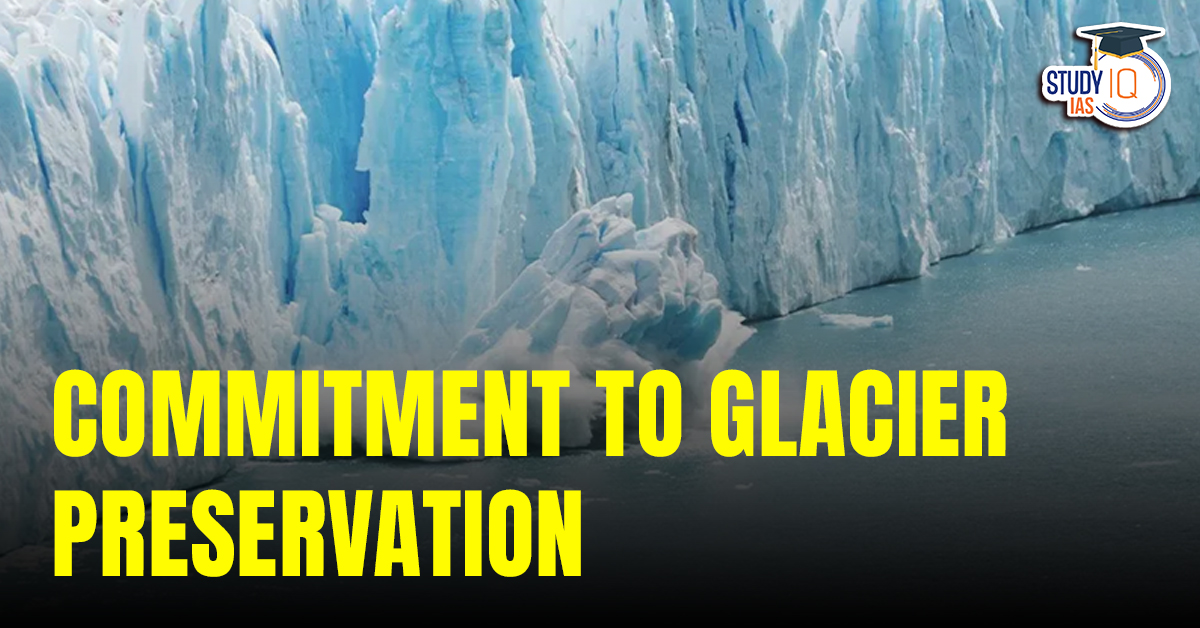Table of Contents
Context: India reaffirms its commitment to glacier preservation at the Plenary Session of the High-Level International Conference on Glaciers in Dushanbe, Tajikistan.
Importance of Glacier Preservation
- Freshwater Reservoirs: Glaciers store about 70% of the world’s freshwater, making them the largest freshwater reservoirs on Earth.
- Water Supply: In Asia, the Ganges River, originating from the Gangotri Glacier, supports around 400 million people.
- Regulating Climate: Glaciers reflect sunlight due to their high albedo, helping to regulate Earth’s temperature.
- Economic Value: Glaciers attract millions of tourists annually, supporting local economies.
- For example, glacier tourism in New Zealand contributes over USD $81 million/ year.
- Cultural and Spiritual Significance: Many Indigenous communities view glaciers as sacred.
- For example, the Snow Star Festival in Peru’s Andes celebrates the spiritual importance of glaciers.
Current Challenges to Glacier Preservation
- Climate Change Result to Massive Ice Loss: Between 2000 and 2023, glaciers lost an average of 273 billion tonnes per year (according to World Meteorological Organisation (WMO)).
- Natural Hazards: In May 2025, the Swiss village of Blatten was nearly destroyed by a massive landslide triggered by Birch glacier collapse, highlighting the increasing instability in alpine regions.
- Glacial Lake Outburst Floods (GLOFs): More than 15 million people globally are at high risk from GLOFs, with countries like India, Pakistan, Peru, and China facing the greatest dangers.
- Inevitable Loss: Even if global warming is limited to 5°C, nearly 40% of the world’s glaciers are projected to disappear.
- If temperatures rise by 7°C, up to 75% could be lost, significantly impacting sea levels and freshwater availability.
- Rising Sea Levels and Flood Risks: The melting of glaciers between 2000-2023 contributed about 18 mm to global sea-level rise during that period.
- Glacier melt is now the second-largest contributor to global sea-level rise, after ocean warming.
- Glacier melt is now the second-largest contributor to global sea-level rise, after ocean warming.
- Geopolitical and Resource Tensions: As glacial water resources dwindle, transboundary tensions may rise, especially in regions where rivers cross national borders (e.g., the Hindu Kush-Himalayan region).
- Competition for shrinking water supplies could exacerbate political disputes between countries sharing glacial rivers.
| Initiatives Taken For Glacier Preservation |
India’s Initiatives
Global Initiatives
|
International Year of Glaciers Preservation 2025
The United Nations has designated 2025 as the International Year of Glaciers’ Preservation (IYGP), and it aims to bring international attention to the essential contribution that glaciers make to the Earth’s climate system and freshwater supplies. This joint effort, co-facilitated by UNESCO and the World Meteorological Organization (WMO), hopes to underscore the imperative action needed to safeguard these precious natural resources.
As part of this designation, March 21st has been declared as the World Day for Glaciers every year, beginning in 2025. The year-long initiative features several events and activities aimed at involving policymakers, scientists, and the general public in actions to conserve glaciers. Central among these is the official launch on January 21, 2025, at WMO headquarters in Geneva, and a High-Level International Conference on Glaciers’ Preservation set for May 29 to June 1, 2025, in Dushanbe, Tajikistan.
Glaciers are receding at record rates as a result of climate change, impacting water security for millions and driving sea-level rise. The IYGP 2025 will facilitate research, policy innovation, and sustainable action to reduce these effects and help glaciers endure for future generations.
Way Forward
- Aggressively Reduce Greenhouse Gas Emissions: Limiting global warming to the Paris Agreement target of 5°C is crucial.
- Explore Innovative Geoengineering Solutions: New engineering solutions are being developed to slow down glacier melt.
- These include underwater curtains (to block warm ocean currents from reaching glaciers) and albedo enhancement (through the application of reflective materials like glass microspheres to glacier surfaces).
- Implement Localized Adaptation and Ecosystem Restoration: Communities are adopting innovative measures such as Ice Stupas in Ladakh, India, which are artificial glaciers that store winter water for dry seasons.
- Additionally, reforestation and ecosystem restoration in glacial watersheds can stabilize local climates, slow ice loss, and enhance carbon sequestration.
- Enhance Monitoring, Research, and Data Preservation: Advanced technologies like remote sensing (satellite imagery and deep learning) are improving glacier mapping and change detection.
- Projects like the Ice Memory initiative are vital for archiving ice cores from endangered glaciers, preserving invaluable climate records for future scientific research.
- Strengthen Global Policy and International Collaboration: Advocate for and participate in international efforts that prioritize glacier preservation (initiatives such as the International Year of Glaciers’ Preservation (2025).


 List of National Parks in India 2025, Ch...
List of National Parks in India 2025, Ch...
 Bonnet Macaques: Habitat, Features, Beha...
Bonnet Macaques: Habitat, Features, Beha...
 Periyar Tiger Reserve, Map, Flora, Fauna...
Periyar Tiger Reserve, Map, Flora, Fauna...

























